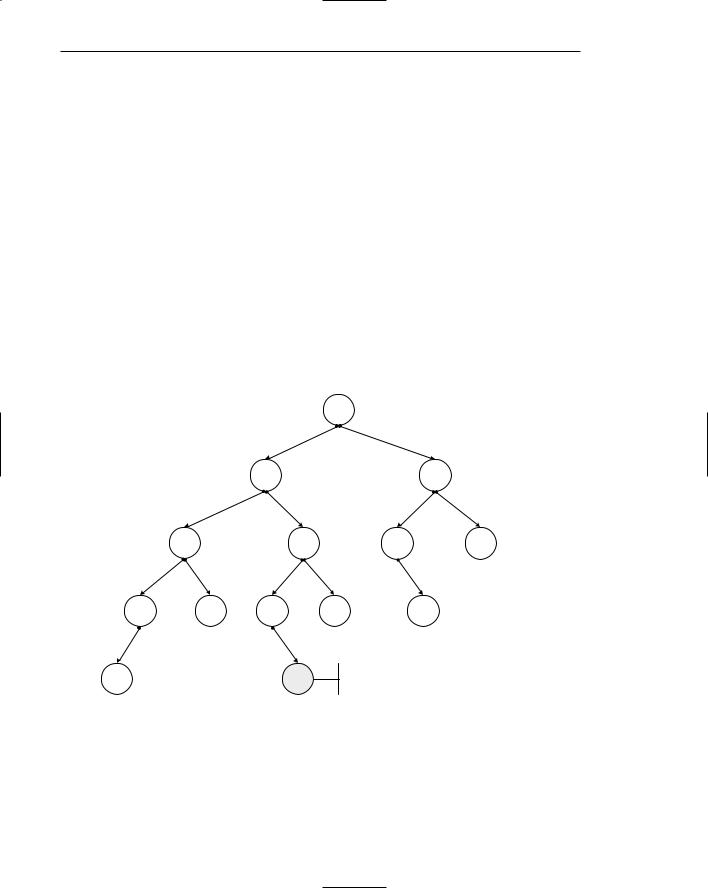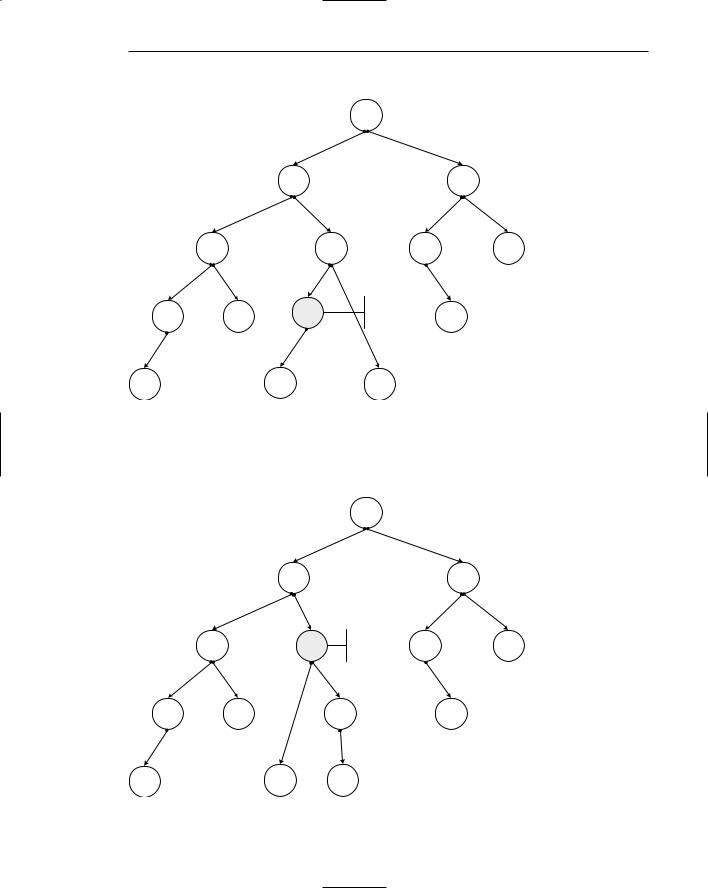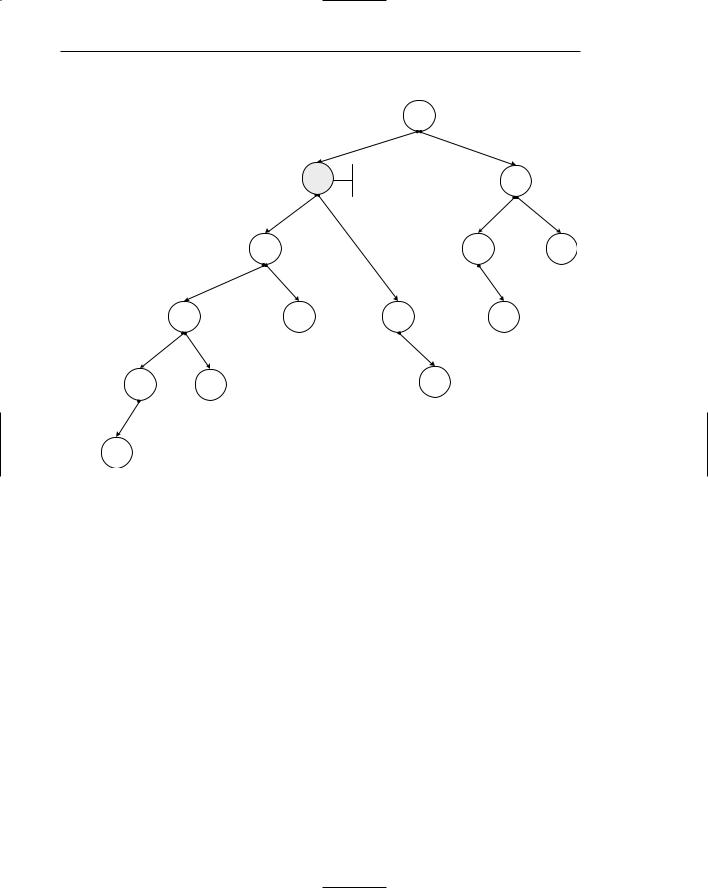
Eilam E.Reversing.Secrets of reverse engineering.2005
.pdf
|
Beyond the Documentation 181 |
|
|
|
|
7C924E59 |
SHR ECX,2 |
|
7C924E5C |
LEA EDI,DWORD PTR [EBX+18] |
|
7C924E5F |
REP MOVS DWORD PTR ES:[EDI],DWORD PTR [ESI] |
|
7C924E61 |
MOV ECX,EAX |
|
7C924E63 |
AND ECX,3 |
|
7C924E66 |
REP MOVS BYTE PTR ES:[EDI],BYTE PTR [ESI] |
|
7C924E68 |
PUSH EBX |
|
7C924E69 |
CALL ntdll.RtlSplay |
|
7C924E6E |
MOV ECX,DWORD PTR [EBP+8] |
|
7C924E71 |
MOV DWORD PTR [ECX],EAX |
|
7C924E73 |
MOV EAX,DWORD PTR [EBP+14] |
|
7C924E76 |
TEST EAX,EAX |
|
7C924E78 |
JNZ ntdll.7C935D4F |
|
7C924E7E |
LEA EAX,DWORD PTR [EBX+18] |
|
7C924E81 |
POP EDI |
|
7C924E82 |
POP ESI |
|
7C924E83 |
POP EBX |
|
7C924E84 |
POP EBP |
|
7C924E85 |
RET 18 |
|
7C924E88 |
MOV DWORD PTR [ESI],EBX |
|
7C924E8A |
JMP SHORT ntdll.7C924E52 |
|
7C924E8C |
XOR EAX,EAX |
|
7C924E8E |
JMP ntdll.7C9214B6 |
|
|
|
|
Listing 5.7 (continued)
Like the function at Listing 5.6, this one also starts with that dummy MOV EDI, EDI instruction. However, unlike the previous function, this one doesn’t seem to receive any parameters through registers, indicating that it was probably not defined using the static keyword. This function starts out by checking the value of the SearchResult parameter (the last parameter it takes), and making one of those remote, out of function jumps if SearchResult == 1. We’ll deal with this condition later.
For now, here’s the code that gets executed when that condition isn’t satisfied.
7C924E02 |
MOV EDI,DWORD PTR [EBP+10] |
7C924E05 |
MOV ESI,DWORD PTR [EBP+8] |
7C924E08 |
LEA EAX,DWORD PTR [EDI+18] |
7C924E0B |
PUSH EAX |
7C924E0C |
PUSH ESI |
7C924E0D |
CALL DWORD PTR [ESI+1C] |
It seems that the TABLE data structure contains another callback pointer. Offset +1c appears to be another callback function that takes two parameters. Let’s examine those parameters and try to figure out what the callback does. The first parameter comes from ESI and is quite clearly the TABLE pointer. What does

182Chapter 5
the second parameter contain? Essentially, it is the value of the third parameter passed to RtlRealInsertElementWorker plus 18 bytes (hex). When you looked earlier at the parameters that RtlRealInsertElementWorker takes, you had no idea what the third parameter was, but the number 0x18 sounds somehow familiar. Remember how RtlLocateNodeGenericTable added 0x18 (24 in decimal) to the pointer of the current element before it passed it to the TABLE_COMPARE_ELEMENTS callback? I suspected that adding 24 bytes was a way of skipping the element’s header and getting to the actual data. This corroborates that assumption—it looks like elements in a generic table are each stored with 24-byte headers that are followed by the element’s data.
Let’s dig further into this function to try and figure out how it works and what the callback does. Here’s what happens after the callback returns.
7C924E10 |
MOV EBX,EAX |
|
7C924E12 |
TEST EBX,EBX |
|
7C924E14 |
JE ntdll.7C94D4BE |
|
7C924E1A |
AND DWORD PTR |
[EBX+4],0 |
7C924E1E |
AND DWORD PTR |
[EBX+8],0 |
7C924E22 |
MOV DWORD PTR |
[EBX],EBX |
7C924E24 |
LEA ECX,DWORD |
PTR [ESI+4] |
7C924E27 |
MOV EDX,DWORD |
PTR [ECX+4] |
7C924E2A |
LEA EAX,DWORD |
PTR [EBX+C] |
7C924E2D |
MOV DWORD PTR |
[EAX],ECX |
7C924E2F |
MOV DWORD PTR |
[EAX+4],EDX |
7C924E32 |
MOV DWORD PTR |
[EDX],EAX |
7C924E34 |
MOV DWORD PTR |
[ECX+4],EAX |
7C924E37 |
INC DWORD PTR |
[ESI+14] |
7C924E3A |
CMP DWORD PTR |
[EBP+1C],0 |
7C924E3E |
JE SHORT ntdll.7C924E88 |
|
7C924E40 |
CMP DWORD PTR |
[EBP+1C],2 |
7C924E44 |
MOV EAX,DWORD |
PTR [EBP+18] |
7C924E47 |
JE ntdll.7C924F0C |
|
7C924E4D |
MOV DWORD PTR |
[EAX+8],EBX |
7C924E50 |
MOV DWORD PTR |
[EBX],EAX |
This code tests the return value from the callback. If it’s zero, the function jumps into a remote block. Let’s take a quick look at that block.
7C94D4BE |
MOV EAX,DWORD PTR [EBP+14] |
7C94D4C1 |
TEST EAX,EAX |
7C94D4C3 |
JE SHORT ntdll.7C94D4C7 |
7C94D4C5 |
MOV BYTE PTR [EAX],BL |
7C94D4C7 |
XOR EAX,EAX |
7C94D4C9 |
JMP ntdll.7C924E81 |
This appears to be some kind of failure mode that essentially returns 0 to the caller. Notice how this sequence checks whether the fourth parameter at

Beyond the Documentation 183
[ebp+14] is nonzero. If it is, the function is treating it as a pointer, writing a single byte containing 0 (because we know EBX is going to be zero at this point) into the address pointed by it. It would appear that the fourth parameter is a pointer to some Boolean that’s used for notifying the caller of the function’s success or failure.
Let’s proceed to look at what happens when the callback returns a non- NULL value. It’s not difficult to see that this code is initializing the header of the newly allocated element, using the callback’s return value as the address. Before we try to figure out the details of this initialization, let’s pause for a second and try to realize what this tells us about the callback function we just observed. It looks as if the purpose of the callback function was to allocate memory for the newly created element. We know this because EBX now contains the return value from the callback, and it’s definitely being used as a pointer to a new element that’s currently being initialized. With this information, let’s try to define this callback.
typedef NODE * ( _stdcall * TABLE_ALLOCATE_ELEMENT) (
TABLE *pTable,
ULONG ElementSize
);
How did I know that the second parameter is the element’s size? It’s simple. This is a value that was passed along from the caller of RtlInsertElement GenericTable into RtlRealInsertElementWorker, was incremented by 24, and was finally fed into TABLE_ALLOCATE_ELEMENT. Clearly the application calling RtlInsertElementGenericTable is supplying the size of this element, and the function is adding 24 because that’s the length of the node’s header. Because of this we now also know that the third parameter passed into RtlRealInsertElementWorker is the user-supplied element length. We’ve also found out that the fourth parameter is an optional pointer into some Boolean that contains the outcome of this function. Let’s correct the original prototype.
UNKNOWN RtlRealInsertElementWorker(
TABLE *pTable,
PVOID ElementData,
ULONG ElementSize,
BOOLEAN *pResult OPTIONAL,
NODE *pNode,
ULONG SearchResult );
You may notice that we’ve been accumulating quite a bit of information on the parameters that RtlInsertElementGenericTable takes. We’re now ready to start looking at the prototype for RtlInsertElementGenericTable.

184 Chapter 5
UNKNOWN NTAPI RtlInsertElementGenericTable(
TABLE *pTable,
PVOID ElementData,
ULONG DataLength,
BOOLEAN *pResult OPTIONAL,
);
At this point in the game, you’ve gained quite a bit of knowledge on this API and associated data structures. There’s probably no real need to even try and figure out each and every member in a node’s header, but let’s look at that code sequence and try and figure out how the new element is linked into the existing data structure.
Linking the Element
First of all, you can see that the function is accessing the element header through EBX, and then it loads EAX with EBX + c, and accesses members through EAX. This indicates that there is some kind of a data structure at offset +c of the element’s header. Why else would the compiler access these members through another register? Why not just use EBX for accessing all the members?
Also, you’re now seeing distinct proof that the generic table maintains both a linked list and a tree. EAX is loaded with the starting address of the linked list header (LIST_ENTRY *), and EBX is used for accessing the binary tree members. The function checks the SearchResult parameter before the tree node gets attached to the rest of the tree. If it is 0, the code jumps to ntdll
.7C924E88, which is right after the end of the function’s main body. Here is the code for that condition.
7C924E88 MOV DWORD PTR [ESI],EBX
7C924E8A JMP SHORT ntdll.7C924E52
In this case, the node is attached as the root of the tree. If SearchResult is nonzero, the code proceeds into what is clearly an if-else block that is entered when SearchResult != 2. If that conditional block is entered (when SearchResult != 2), the code takes the pNode parameter (which is the node that was found in RtlLocateNodeGenericTable), and attaches the newly created node as the left child (offset +8). If SearchResult == 2, the code jumps to the following sequence.
7C924F0C MOV DWORD PTR [EAX+4],EBX
7C924F0F JMP ntdll.7C924E50
Here the newly created element is attached as the right child of pNode (offset +4). Clearly, the search result indicates whether the new element is smaller or larger than the value represented by pNode. Immediately after the ‘if-else’

Beyond the Documentation 185
block a pointer to pNode is stored in offset +0 at the new entry. This indicates that offset +0 in the node header contains a pointer to the parent element. You can now properly define the node header data structure.
struct NODE
{
NODE *ParentNode;
NODE *RightChild;
NODE *LeftChild;
LIST_ENTRY LLEntry;
ULONG Unknown;
};
Copying the Element
After allocating the new node and attaching it to pNode, you reach an interesting sequence that is actually quite common and is one that you’re probably going to see quite often while reversing IA-32 assembly language code. Let’s take a look.
7C924E52 |
MOV ESI,DWORD PTR [EBP+C] |
7C924E55 |
MOV ECX,EDI |
7C924E57 |
MOV EAX,ECX |
7C924E59 |
SHR ECX,2 |
7C924E5C |
LEA EDI,DWORD PTR [EBX+18] |
7C924E5F |
REP MOVS DWORD PTR ES:[EDI],DWORD PTR [ESI] |
7C924E61 |
MOV ECX,EAX |
7C924E63 |
AND ECX,3 |
7C924E66 |
REP MOVS BYTE PTR ES:[EDI],BYTE PTR [ESI] |
This code loads ESI with ElementData, EDI with the end of the new node’s header, ECX with ElementSize * 4, and starts copying the element data, 4 bytes at a time. Notice that there are two copying sequences. The first is for 4-byte chunks, and the second checks whether there are any bytes left to be copied, and copies those (notice how the first MOVS takes DWORD PTR arguments and the second takes BYTE PTR operands).
I say that this is a common sequence because this is a classic memcpy implementation. In fact, it is very likely that the source code contained a memcpy call and that the compiler simply implemented it as an intrinsic function (intrinsic functions are briefly discussed in Chapter 7).
Splaying the Table
Let’s proceed to the next code sequence. Notice that there are two different paths that could have gotten us to this point. One is through the path I have just covered in which the callback is called and the structure is initialized, and

186 Chapter 5
the other is taken when SearchResult == 1 at that first branch in the beginning of the function (at ntdll.7C924DFC). Notice that this branch doesn’t go straight to where we are now—it goes through a relocated block at ntdll
.7C935D5D. Regardless of how we got here, let’s look at where we are now.
7C924E68 |
PUSH EBX |
|
7C924E69 |
CALL ntdll.RtlSplay |
|
7C924E6E |
MOV ECX,DWORD |
PTR [EBP+8] |
7C924E71 |
MOV DWORD PTR |
[ECX],EAX |
7C924E73 |
MOV EAX,DWORD |
PTR [EBP+14] |
7C924E76 |
TEST EAX,EAX |
|
7C924E78 |
JNZ ntdll.7C935D4F |
|
7C924E7E |
LEA EAX,DWORD |
PTR [EBX+18] |
This sequence calls a function called RtlSplay (whose name you have because it is exported—remember, I’m not using the Windows debug symbol files!). RtlSplay takes one parameter. If SearchResult == 1 that parameter is the pNode parameter passed to RtlRealInsertElementWorker. If it’s anything else, RtlSplay takes a pointer to the new element that was just inserted. Afterward the tree root pointer at pTable is set to the return value of RtlSplay, which indicates that RtlSplay returns a tree node, but you don’t really know what that node is at the moment.
The code that follows checks for the optional Boolean pointer and if it exists it is set to TRUE if SearchResult != 1. The function then loads the return value into EAX. It turns out that RtlRealInsertElementWorker simply returns the pointer to the data of the newly allocated element. Here’s a corrected prototype for RtlRealInsertElementWorker.
PVOID RtlRealInsertElementWorker(
TABLE *pTable,
PVOID ElementData,
ULONG ElementSize,
BOOLEAN *pResult OPTIONAL,
NODE *pNode,
ULONG SearchResult );
Also, because RtlInsertElementGenericTable returns the return value of RtlRealInsertElementWorker, you can also update the prototype for RtlInsertElementGenericTable.
PVOID NTAPI RtlInsertElementGenericTable(
TABLE *pTable,
PVOID ElementData,
ULONG DataLength,
BOOLEAN *pResult OPTIONAL,
);

Beyond the Documentation 187
Splay Trees
At this point, one thing you’re still not sure about is that RtlSplay function. I will not include it here because it is quite long and convoluted, and on top of that it appears to be distributed throughout the module, which makes it even more difficult to read. The fact is that you can pretty much start using the generic table without understanding RtlSplay, but you should probably still take a quick look at what it does, just to make sure you fully understand the generic table data structure.
The algorithm implemented in RtlSplay is quite involved, but a quick examination of what it does shows that it has something to do with the rebalancing of the tree structure. In binary trees, rebalancing is the process of restructuring the tree so that the elements are divided as evenly as possible under each side of each node. Normally, rebalancing means that an algorithm must check that the root node actually represents the median value represented by the tree. However, because elements in the generic table are userdefined, RtlSplay would have to make a callback into the user’s code in order to compare elements, and there is no such callback in this function.
A more careful inspection of RtlSplay reveals that it’s basically taking the specified node and moving it upward in the tree (you might want to run RtlSplay in a debugger in order to get a clear view of this process). Eventually, the function returns the pointer to the same node it originally starts with, except that now this node is the root of the entire tree, and the rest of the elements are distributed between the current element’s left and right child nodes.
Once I realized that this is what RtlSplay does the picture became a bit clearer. It turns out that the generic table is implemented using a splay tree [Tarjan] Robert Endre Tarjan, Daniel Dominic Sleator. Self-adjusting binary search trees. Journal of the ACM (JACM). Volume 32 , Issue 3, July 1985, which is essentially a binary tree with a unique organization scheme. The problem of properly organizing a binary tree has been heavily researched and there are quite a few techniques that deal with it (If you’re patient, Knuth provides an in-depth examination of most of them in [Knuth3] Donald E. Knuth. The Art of Computer Pro- gramming—Volume 3: Sorting and Searching (Second Edition). Addison Wesley. The primary goal is, of course, to be able to reach elements using the lowest possible number of iterations.
A splay tree (also known as a self-adjusting binary search tree) is an interesting solution to this problem, where every node that is touched (in any operation) is immediately brought to the top of the tree. This makes the tree act like a cache of sorts, whereby the most recently used items are always readily available, and the least used items are tucked at the bottom of the tree. By definition, splay trees always rotate the most recently used item to the top of the tree. This is why

188Chapter 5
you’re seeing a call to RtlSplay immediately after adding a new element (the new element becomes the root of the tree), and you should also see a call to the same function after deleting and even just searching for an element.
Figures 5.1 through 5.5 demonstrate how RtlSplay progressively raises the newly added item in the tree’s hierarchy until it becomes the root node.
RtlLookupElementGenericTable
Remember how before you started digging into the generic table I mentioned two functions (RtlGetElementGenericTable and RtlLookupElement GenericTable) that appeared to be responsible for retrieving elements? Because you know that RtlGetElementGenericTable searches for an element by its index, RtlLookupElementGenericTable must be the one that provides some sort of search capabilities for a generic table. Let’s have a look at RtlLookupElementGenericTable (see Listing 5.8).
Root Node
113
58 |
130 |
31 |
82 |
119 |
146 |
13 |
35 |
71 |
90 |
124 |
4 |
74 |
Item We’ve |
|
Just Added |
|||
|
|
Figure 5.1 Binary tree after adding a new item. New item is connected to the tree at the most appropriate position, but no other items are moved.

Beyond the Documentation 189
Root Node
113
58 |
130 |
|
31 |
82 |
119 |
146 |
|
13 |
35 |
74 |
Item We’ve |
124 |
|
Just Added |
|||||
|
4 |
71 |
90 |
Figure 5.2 Binary tree after first splaying step. The new item has been moved up by one level, toward the root of the tree. The previous parent of our new item is now its child.
Root Node
113
58 |
130 |
31 |
74 |
Item We’ve |
119 |
146 |
|
Just Added |
|||||
|
|
|
|
13 |
35 |
82 |
124 |
4 |
71 |
90 |
Figure 5.3 Binary tree after second splaying step. The new item has been moved up by another level.

190 Chapter 5
|
Root Node |
|
|
|
113 |
|
|
74 |
Item We’ve |
130 |
|
Just Added |
|||
|
|
58 |
119 |
146 |
31 |
71 |
82 |
124 |
13 |
35 |
90 |
4
Figure 5.4 Binary tree after third splaying step. The new item has been moved up by yet another level.
7C9215BB |
PUSH EBP |
7C9215BC |
MOV EBP,ESP |
7C9215BE |
LEA EAX,DWORD PTR [EBP+C] |
7C9215C1 |
PUSH EAX |
7C9215C2 |
LEA EAX,DWORD PTR [EBP+8] |
7C9215C5 |
PUSH EAX |
7C9215C6 |
PUSH DWORD PTR [EBP+C] |
7C9215C9 |
PUSH DWORD PTR [EBP+8] |
7C9215CC |
CALL ntdll.7C9215DA |
7C9215D1 |
POP EBP |
7C9215D2 |
RET 8 |
|
|
Listing 5.8 Disassembly of RtlLookupElementGenericTable.
